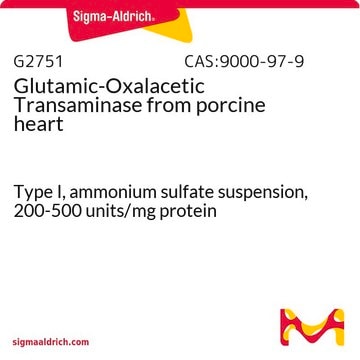A3809
Asparaginase from Escherichia coli
lyophilized powder, 100-300 units/mg protein (biuret)
Sinónimos:
L-Asparagine Amidohydrolase
About This Item
Productos recomendados
formulario
lyophilized powder
Nivel de calidad
actividad específica
100-300 units/mg protein (biuret)
composición
Protein, ≥60%
temp. de almacenamiento
2-8°C
¿Está buscando productos similares? Visita Guía de comparación de productos
Descripción general
Aplicación
- to compare the cytotoxic effect of L-asparaginase purified from Streptomyces brollosae NEAE-115
- as a standard in asparaginase assay to quantify asparaginase activities in various eel tissues
- to elicit amino acid deprivation
Acciones bioquímicas o fisiológicas
Definición de unidad
Forma física
Nota de preparación
Nota de análisis
Palabra de señalización
Warning
Frases de peligro
Consejos de prudencia
Clasificaciones de peligro
Repr. 2 - Skin Sens. 1
Código de clase de almacenamiento
11 - Combustible Solids
Clase de riesgo para el agua (WGK)
WGK 3
Punto de inflamabilidad (°F)
Not applicable
Punto de inflamabilidad (°C)
Not applicable
Equipo de protección personal
Eyeshields, Faceshields, Gloves, type P3 (EN 143) respirator cartridges
Certificados de análisis (COA)
Busque Certificados de análisis (COA) introduciendo el número de lote del producto. Los números de lote se encuentran en la etiqueta del producto después de las palabras «Lot» o «Batch»
¿Ya tiene este producto?
Encuentre la documentación para los productos que ha comprado recientemente en la Biblioteca de documentos.
Los clientes también vieron
Nuestro equipo de científicos tiene experiencia en todas las áreas de investigación: Ciencias de la vida, Ciencia de los materiales, Síntesis química, Cromatografía, Analítica y muchas otras.
Póngase en contacto con el Servicio técnico










